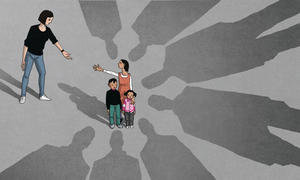article
3,328 Results
article
The Lessons Are All Around You
Years ago, I was inspired by Douglas Brinkley’s The Majic Bus: An American Odyssey. In it, Brinkley described how he taught history to college students. He took them to historical sites and had them speak with eyewitnesses. Wanting this, but not knowing how to pay for it, I looked inward. I realized that our high school campus was surrounded by history, just like every other place.
professional development
Supreme Court Re-Examines 1965 Voting Rights Act Transcript
This piece is to accompany African Americans Face and Fight Obstacles to Voting. Watch the video here.
November 4, 2011
article
The Height of Unintended Bias
The Southern Poverty Law Center held a Health Fair yesterday at which employees could get their blood pressure checked, visit with fitness experts and determine their fat-to-muscle ratio. Our screening began with a familiar ritual of childhood physicals: We each stepped onto a platform, stood much straighter than usual and had our height measured. And then something very interesting happened. Each and every person, upon hearing the result, insisted they were taller, questioned the accuracy of the device (a steel measure) and reacted as if they’d been denied a birthright.
article
Toolkit for "Immigrant and Refugee Children: A Guide for Educators and School Support Staff"

Support and affirm your immigrant students with these resources.
article
Restoring Math Confidence for Girls
“I'm just not good at math,” my daughter grumbled under her breath. I was surprised. Where did she get that idea, I wondered. As far as I can remember she has loved numbers and was quick to pick up math concepts. However, I began to see her confidence slowly wither and her frustration rise. It started in the 2nd grade. And, now, she sat at the kitchen table with pencil in hand, ready to give up, convinced she just couldn't do it anymore.
article
Avoid Disaster: Assign Seating in Middle School
Have you noticed students being excluded in your classroom? A new seating arrangement can make all the difference.
article
‘Mountaintop’ Helps Students Continue King’s Work
A few years ago, First Lady Michelle Obama was criticized for revealing some not-so-flattering details about her husband, Barack: He snores. His morning breath is “stinky.” He never picks up his dirty socks. To those who said this was too much information about the president of the United States, Mrs. Obama had an answer. “Barack is very much human,” she told Glamour magazine, “so let’s not deify him.” Putting somebody on a pedestal, she said, is only preparation for knocking him from it.
lesson
Los Héroes y las Heroínas
Through songs, stories and paintings, students explore how and why communities tell stories about heroes and heroines.
August 25, 2011
